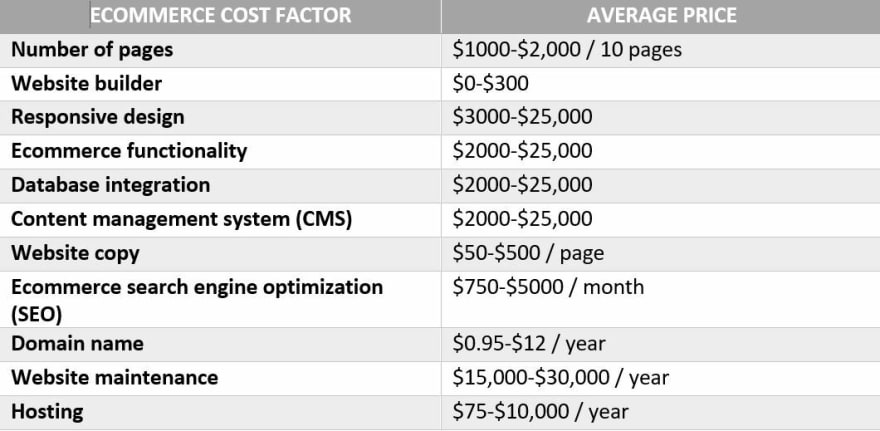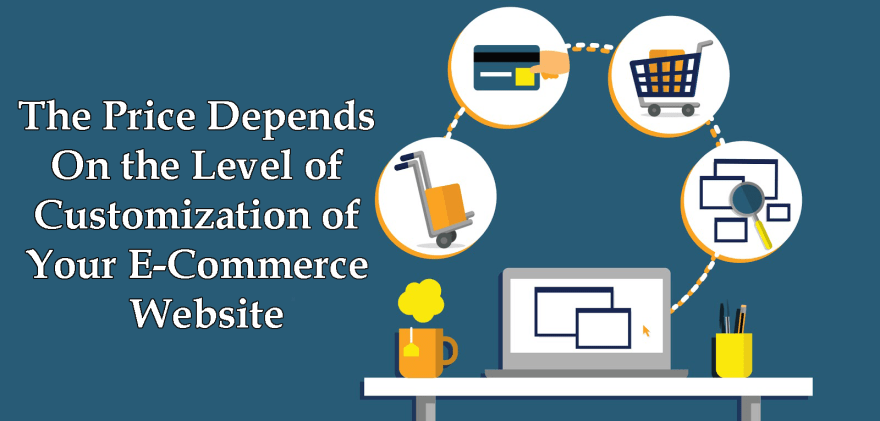This is a question that many are asking: what is the cost of an e-commerce website? This is a perfectly normal question, and it is legitimate for you to ask it. Only, answering it is not so simple and depends on your project, the chosen solution, the degree of personalization of the website, the functionalities. In short, a very large number of factors. In this article, we will try to present the different types of e-commerce websites that can be created, and the prices associated with them.
How Much Does an E-Commerce Website Development Cost, The Summary?
• The price depends on the type of solution used to create the e-commerce website
• The price depends on the level of customization of your e-commerce website
• Breakdown of the main costs of an e-commerce website
The price depends on the type of solution used to create the ecommerce Website
1. E-commerce website created with web software like Shopify
You will find numerous proprietary software on the internet allowing you to create your own e-commerce website, but you must above all look at the different prices such as Wizishop, Shopify prices. This software is designed to create an e-commerce website without special technical skills and has a very simple user interface: you select the theme that corresponds to your business and your needs, and you configure this theme. If you want to create an ecommerce website, you can opt for a solution like Shopify. This is one of the key solutions when it comes to ecommerce. It has evolved with the times, especially in terms of personalization.
Then you just have to put it online!
Regarding the price of such a solution, count between 12 Dollar and 32 Dollar per month.
2. Little personalized e-commerce website created with an open-source CMS
If your product catalog has several thousand products, and you choose the proprietary software solution, browsing your website may be very difficult. If you don't have a big budget, you can opt for an e-commerce website solution created using an open-source CMS. You need to think about comparing hosting software. This solution will make navigation easier and more pleasant for the Internet user:
E-commerce websites created in open source are generally more qualitative, although the limits in terms of customization are quickly reached. Thanks to open-source CMS, you will above all benefit from a more complete and flexible back-end, allowing you to manage all your product sheets and all your page templates.
Regarding the price of such a solution, count between 4,000 Dollar and 20,000 Dollar. The price range is quite wide, as you can see: in fact, the price will depend on the level of customization of your e-commerce website. Needless to say, the more the customization is pushed, the more the prices go up!
3. Very personalized e-commerce website
If you want to create an e-commerce website that is unlike any other, that has its own brand and reflects the values of your company, that clearly stands out from the competition, you must plan for a substantial budget. In the same way, the more specific your need, the more customization of the website is necessary. However, in this matter, the rule is very simple: the more the website is personalized, the higher the price, unlike the price of a showcase website. For at least two reasons: first, you will be forced to use more flexible, and therefore more complex, and therefore more expensive technologies. Second, you will have to call on a developer who will offer you a tailor-made service.
To create a very personalized e-commerce website, meeting very specific needs, two solutions are available to you:
• Use an open-source CMS- But it is obvious that many modifications will undoubtedly have to be made to make the internal specifications of the CMS coincide with your needs.
• Create a fully bespoke website-This solution, the most expensive but the most qualitative, is meeting with increasing success.
In both cases, the use of a developer service provider is necessary. This obviously has an impact on the price of your e-commerce website. Count at least 22,000 – 33,000 Dollar. Of course, these are only indicative prices. Who says tailor-made service says tailor-made price: the price will therefore be very variable and will depend on your e-commerce specifications and your e-commerce business plan.
The Price Depends On the Level of Customization of Your E-Commerce Website
As said before, the variable that plays the biggest role in determining the final price is the degree of personalization of the website: Price. Personalization concerns both the exterior design of the store (front-end), visible to the Internet user, and the back-end.
1. Shop Design Customization
The design of an e-commerce website is obviously essential. A user who arrives at a “well done”, “beautiful” and “well-designed” website will be more likely to stay, buy and come back. The design has a real impact on the conversion rate. It is therefore very important to take care of the design of the website. The design can be more or less personalized, and in any case, considered at two different levels:
The purely aesthetic, graphic aspect: choice of theme, templates, font, colors… But also: the way of arranging the text and photos etc. In short, the appearance of your website. The functional or ergonomic aspect: mode of navigation on the website, organization of content, interactivity, customized pages, functionalities, etc. These two aspects are inseparable in reality: a “well done” website is often a “beautiful” website and vice versa.
It is very difficult to offer Internet users an ultra-design website through a web software solution or even an open-source CMS.
2. Personalization of the Back-End
Everyone may not be familiar with the concept of back-end applied to the web. In fact, it's very simple: the back-end is the whole part of the website which is only accessible to the administrator and which allows you to manage the content and the functionalities of the website. In the context of an e-commerce website, the back-end encompasses elements as diverse as: management of product sheets, categories, means of payment, monitoring of invoicing, orders and deliveries, statistics and conversion rate analysis systems, the possibility of creating new product sheets and new catalogs, the customer area, promotions and loyalty systems, inventory management, integration of social networks into the interface.
The back-end is opposed to the front-end, the part visible to users of the website. For you to be able to use your website as you wish, the back-end must be customized and adapted to your needs. The costs can be important to match your needs/requirements with the back-end of your website. These two aspects (front-end and back-end) are inseparable: the richness of a back-end is generally reflected in the quality of your front-end. We have a real Appearance/Essence relationship between the two.
Focus On the Main Items of Expenditure to Create an E-Commerce Website
Custom template: you must choose a template and customize it according to your specific needs. A template is a website model that must necessarily be adapted, therefore personalized. To take a very general picture, a Word page model is a template. Personalization consists of creating content based on the functionalities of this page template. For a website template, the greater the customization required, the more this cost item will weigh (the template itself is mostly not very expensive. Some are even free). Warning: if you create a completely custom website, you will not use a template.
HTML integration: the HTML integration of your website consists of transforming your graphic model (the visual you want to obtain) into a web language understandable by browsers, for example. In other words, in a shorter way: it's about transforming graphics, visuals into coded language. It is a very technical phase and which, therefore, is quite expensive.
Catalog management: this cost item is specific to e-commerce websites. It incorporates all the work of importing product sheets, managing special cases, categorizing different products, etc. This is to adapt your real catalog to the web format.
Adaptation of the Back-End: if you have read the article, you now know what it is about. To adapt to your needs, the back-end (the administrator interface of your website) must be personalized. This cost item can be very significant if you opt for a software solution, especially with the costs of maintaining the website. The software presents a “general” back-end, not necessarily adapted to your specific needs. This cost item can be minimal if the level of customization required is low.
SEO optimization: if you create an e-commerce website, the goal is for it to be visited. Before even converting visitors into buyers, you must have visitors! The work of SEO optimization consists in making your website more visible on the internet, by making it appear in a good position on certain targeted queries. This position should not be neglected: having a good website is not enough, it still has to be visible on the web!
Check: this phase is the final step in creating your website. Its function is to test the website, to check that everything works as it should, that your specifications have been taken into account by the developers, etc.
Final Words
It’s just significant that you take your time and figure them out before you spend big on an e-commerce website. This article can help you determine your E-Commerce Website Development Cost upfront.






Top comments (4)
Thanks! I also read at Cleveroad that the cost of development is from $20,150 to $28,800 and up only to develop the features. The exact cost depends on how complex your website is going to be, whether you need custom UI design, 3-rd party integrations, and additional services.
Hub's dynamic feature set, including real-time editing, is perfect for creating modern websites. Its flexibility and integration with major plugins enhance functionality, crucial for businesses looking to scale. The theme also offers an impressive array of pre-designed elements and modules, which can be combined in various ways to create unique and effective user interfaces. Additionally, Hub supports full WooCommerce integration, making it an excellent choice for e-commerce ventures. More about its features can be found at perfectwpthemes.com/creating-dynam... , particularly its approach to modern web design, which prioritizes responsiveness and user engagement.
Web developers are facing criticism for imposing high fees on website design projects using WordPress, a platform perceived by many as a straightforward content management system (CMS) that doesn't demand the same coding proficiency as constructing a website from the ground up.
Detractors contend that developers are capitalizing on the user-friendly nature of WordPress, artificially increasing their rates as if they were crafting a sophisticated website from scratch. This approach leaves some clients disheartened and bewildered by the elevated expenses linked to what appears to be a simple task.
Although web developers may demand substantial fees for crafting and constructing a website from the ground up, premium templates usually fall within the $15 to $100 range, often inclusive of lifetime updates and support.
This substantially diminishes the expense associated with website creation, rendering it more affordable to a broader audience, encompassing individuals and small businesses operating within constrained budgets.
The cost can vary based on several factors, with the primary expense being the tech stack you choose. For WooCommerce or Shopify, expect to spend between $800 and $1500. For a more detailed breakdown, check out this blog, which outlines the ideal tech stack, budget, and developer options: (yeasitech.com/shopify-for-small-re...)
Some comments may only be visible to logged-in visitors. Sign in to view all comments.